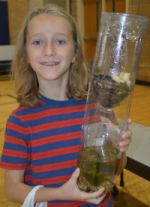Evan Adamy held on to a terrarium-like container fashioned from plastic bottles and pointed out its essential features.
“Down here is some aquatic life and up here is some land life,” said the Wealthy Elementary fourth-grader. “We’re supposed to see what’s going on in there.”

The creation of eco-columns has been a rite of passage for the school’s fourth-graders for more than 20 years. It’s part of the science curriculum unit on ecosystems and adaptation, explained teacher Tim Saunders.
“What’s really great about the lesson is they get to observe like scientists, to ask questions and to see and record how things change over time,” Saunders said. “We really want them to think critically and to not just guess at things, but to make predictions based on observation.”
This year, more than 70 students got help constructing their eco-columns from about a dozen parent volunteers. The school’s PTO paid for materials.

Included in each student’s aquatic habitat: aquarium gravel, water, guppies, snails, algae and seaweed. In the land habitat: soil, crunched-up leaves, grass and mustard seeds, pea plants, pill bugs and crickets. And lots of packing tape to hold it all together.
Students record their observations in class for a week before they are allowed to take their eco-columns home.
“Some kids keep them for years,” teacher Winona Tinholt said. “They just love them.”
Based on observation, Evan predicted there are places at home where it would not be wise to set his eco-column.
“I have these unusual pets called rats, and it probably wouldn’t be good to put this on top of the cage,” he said.









